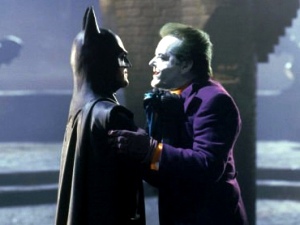Batman (1989)
[9]
It’s hard to believe we once lived in a time when superhero movies didn’t monopolize the multiplexes. Such a time was the summer of 1989, when Warner Brothers’ very first big-screen version of Batman was due to be released. Many declared the film a folly. Indeed, a superhero film hadn’t been successful since Superman II nearly ten years earlier and most of the world still had a bad taste in its mouth from the campy ’60s Batman TV series. But naysayers be damned. Batman wasn’t just a commercial and critical success. It completely overhauled Hollywood’s definition of the word ‘blockbuster’ and kicked off a superhero trend that would last for decades.
Tim Burton’s (Pee Wee’s Big Adventure, Beetlejuice) adaptation of the material is dark, operatic, and visually spectacular. Michael Keaton is surprisingly great as both Bruce Wayne and Batman and Jack Nicholson’s Joker is a scene-stealing villainous performance for the ages. The script is solid, shrewd in its character development, with dramatic heft and action set pieces in all the right places and a terrific conclusion atop the Gotham cathedral. It’s only weak point is before the climax, when the writers try too hard to resolve the romantic relationship. I think it would have been better if Vicki Vale (Kim Basinger) never learned Batman’s identity, but that’s a small quibble in a smorgasbord of delights like this.
Just as vital as the script and performances are Anton Furst’s set design, Bob Ringwood’s wardrobe creations, and Danny Elfman’s rousing score, each examples of superlative movie craftsmanship. With Michael Gough, Pat Hingle, Robert Wuhl, Billy Dee Williams, and Jack Palance.
Academy Award: Best Art Direction



